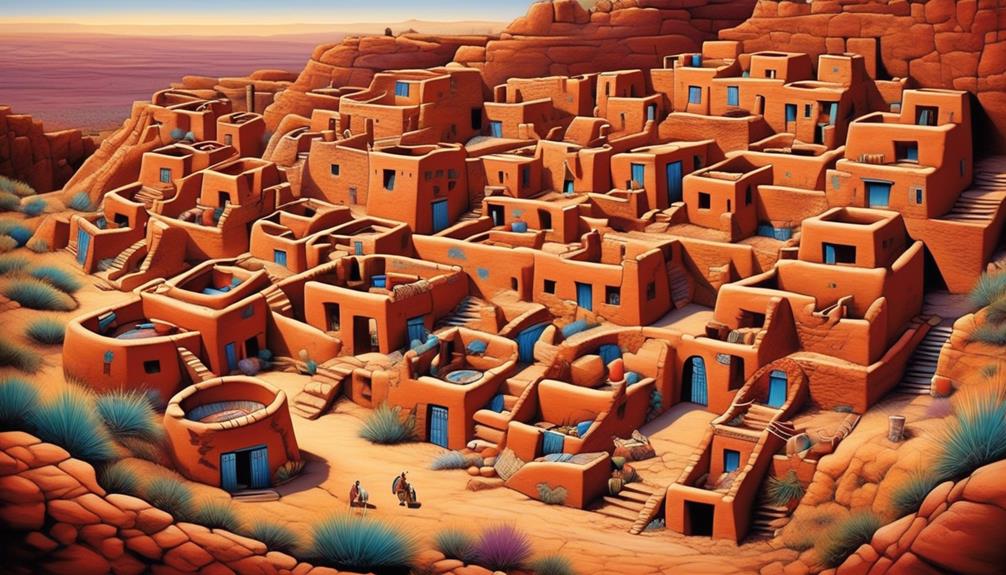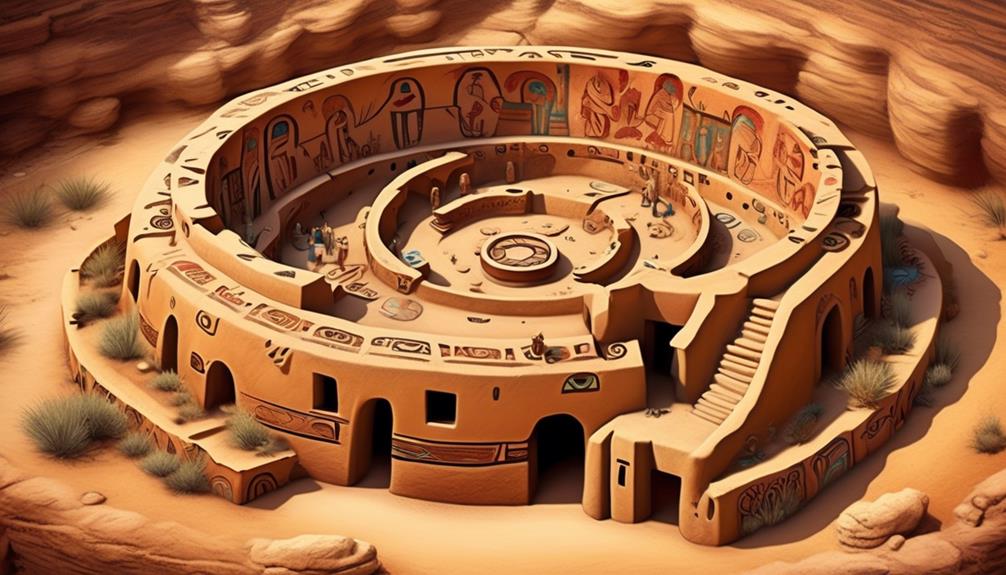Reflecting on the intricate history of the Hopi tribe, we are captivated by the enigmatic story of their origins and early society. It offers a captivating glimpse into the past.
Yet, as we seek to unravel the tale of this enduring tribe, questions arise about the trajectory of their existence. When did the Hopi begin their journey, and what forces shaped the culmination of their tribal legacy?
Join us as we embark on a thought-provoking exploration of the Hopi's historical timeline, seeking to uncover the intricacies of their remarkable narrative.
Key Takeaways
- The Hopi Tribe originated in the American Southwest and settled in the region, developing a deep connection to the land.
- Their agricultural practices, focused on cultivating corn, beans, and squash, allowed them to thrive in harsh conditions.
- The Hopi Tribe has a rich cultural and spiritual tradition, with a wide array of spiritual practices and a reverence for the natural world.
- The arrival of Spanish colonizers brought changes to Hopi society, including the introduction of new crops and livestock, the spread of Christianity, and the imposition of Spanish governance structures.
Origins and Early Settlement
The Hopi Tribe's origins and early settlement can be traced back to a time when their ancestors established a unique and enduring presence in the American Southwest. Early migration patterns indicate that the Hopi people have occupied the same region for over a millennium, creating a deep connection to the land and a rich cultural heritage. Their migration and settlement patterns were influenced by a deep understanding of the environment, allowing them to thrive in what many considered to be harsh conditions.
The Hopi's agricultural practices were central to their ability to flourish in this region. Through the cultivation of corn, beans, and squash, they not only sustained themselves but also developed a complex and sustainable agricultural system. This system formed the foundation of their society, shaping their cultural beliefs and traditions.
The Hopi's early migration and agricultural practices are integral to understanding their historical development and cultural identity. Their ability to adapt to the arid environment and create a thriving agricultural society speaks to their resilience and ingenuity. These early practices continue to influence the Hopi Tribe's cultural and social fabric today.
Cultural and Spiritual Traditions

Establishing a deep connection to the land through enduring migration patterns and sustainable agricultural practices, the Hopi Tribe's cultural and spiritual traditions are rooted in a rich historical heritage. These traditions have been passed down through generations, shaping the Hopi way of life and worldview.
- Spiritual Practices: The Hopi people engage in a wide array of spiritual practices that are deeply intertwined with their daily lives. These practices include prayer, meditation, and offerings to honor their deities and maintain balance in the universe.
- Ceremonial Rituals: Ceremonial rituals hold immense significance in the Hopi culture, serving as a means to connect with the divine, express gratitude, and seek blessings for the community. The performance of rituals such as the Hopi Snake Dance and Powamu ceremony are central to the preservation of their cultural identity.
- Connection to Nature: The Hopi hold a profound reverence for the natural world, viewing the earth as a living entity. Their cultural and spiritual traditions emphasize sustainable interactions with the environment, reflecting a deep understanding of ecological balance and harmony.
- Ancestral Wisdom: The cultural and spiritual traditions of the Hopi Tribe are steeped in ancestral wisdom, encompassing oral traditions, storytelling, and ceremonial knowledge that guide the community in navigating life's challenges and celebrating its joys.
Interaction With Spanish Colonizers
Upon the arrival of Spanish colonizers, the Hopi Tribe's cultural and spiritual traditions faced significant challenges and adaptations, marking a pivotal juncture in their historical narrative. The Spanish contact brought about a period of cultural exchange that deeply influenced the Hopi way of life. This interaction led to a complex amalgamation of traditions, beliefs, and practices, as the Hopi people navigated the impact of Spanish colonization while striving to preserve their unique identity.
| Cultural Exchange with Spanish Colonizers | Impact on Hopi Tribe |
|---|---|
| Introduction of new crops and livestock | Altered traditional Hopi farming and dietary practices |
| Spread of Christianity and religious syncretism | Integration of Christian elements into Hopi spirituality |
| Imposition of Spanish governance structures | Shift in traditional Hopi political and social systems |
The Spanish contact also brought about challenges to the Hopi way of life, including forced labor, disease, and conflict. Despite these adversities, the Hopi people displayed resilience and adaptability, ultimately shaping a unique cultural synthesis that endures to this day. The encounter with Spanish colonizers fundamentally transformed the trajectory of the Hopi Tribe, leaving a lasting imprint on their cultural and spiritual landscape.
Challenges and Adaptations in Modern Times

Facing an evolving world, the Hopi Tribe has encountered a myriad of challenges and navigated through adaptations that have reshaped their cultural and societal dynamics. The resilience of the Hopi people has allowed them to preserve their traditions while embracing aspects of modernity.
- Preservation of Traditions: Despite the challenges posed by modern influences, the Hopi Tribe has remained steadfast in preserving their cultural traditions, including religious ceremonies, language, and artisanal practices.
- Socioeconomic Challenges: The integration of modern economic systems has presented challenges for the Hopi Tribe, as they strive to balance economic development with the preservation of their traditional way of life.
- Environmental Pressures: The rapid environmental changes of modern times, such as climate change and resource exploitation, have posed significant challenges to the traditional Hopi way of life, leading to adaptations in agricultural practices and natural resource management.
- Cultural Identity in a Globalized World: The increasing interconnectedness of the world has necessitated the Hopi Tribe to navigate the complexities of maintaining their cultural identity in the face of globalization, leading to adaptations in education and intercultural exchange programs.
The Hopi Tribe's ability to confront these challenges while staying true to their traditions demonstrates their resilience in the face of modernity.
Contemporary Hopi Identity and Legacy
Navigating the complexities of modern challenges has shaped the contemporary identity and legacy of the Hopi Tribe, illustrating their ongoing resilience and cultural evolution. The preservation of our legacy is a cornerstone of contemporary Hopi identity. Despite the encroachment of modernity, our tribe continues to safeguard and transmit our cultural heritage to future generations.
This commitment to legacy preservation is evident in our unwavering dedication to upholding traditional ceremonies, language, and artistic practices. By doing so, we ensure that the essence of Hopi identity endures, serving as a guiding light for our community.
Cultural identity plays a pivotal role in shaping the contemporary Hopi legacy. As we navigate the complexities of the modern world, our cultural identity remains a source of strength and unity. It serves as a compass, guiding our interactions with the outside world while providing a sense of belonging and purpose within our community.
The fusion of tradition and adaptation has allowed us to carve out a unique space in the contemporary world, solidifying our place in history while embracing the opportunities and challenges of the present. Our legacy of resilience, cultural preservation, and adaptability continues to be an integral part of the contemporary Hopi identity, laying the foundation for future generations to thrive.
Frequently Asked Questions
What Were the Specific Factors That Led to the Decline and Eventual End of the Hopi Tribe?
We've analyzed the specific factors contributing to the decline and eventual end of the Hopi tribe. Factors such as external pressures from European colonization, forced assimilation policies, and the impact of diseases significantly affected the Hopi community.
Additionally, land loss and the disruption of traditional practices played a role in the decline. Understanding these historical influences is crucial in comprehending the challenges faced by the Hopi tribe.
How Did the Hopi Tribe Interact With Other Native American Tribes in the Region?
We, the Hopi, had rich intertribal relations with neighboring tribes. Our trade networks extended far, fostering cultural exchange and diplomatic alliances.
For example, we traded pottery and agricultural goods with the Zuni and Navajo, and engaged in ceremonial exchanges with the Pueblo people. These interactions strengthened our ties and enriched our cultural heritage.
Our history is a testament to the importance of intertribal relations in shaping our identity and resilience.
What Are Some of the Lesser-Known Cultural and Spiritual Traditions Practiced by the Hopi Tribe?
Ceremonial rituals hold significant cultural and spiritual importance for the Hopi tribe. These traditions are intricately tied to agricultural practices, reflecting the deep connection between the Hopi people and the land.
Lesser-known ceremonies, such as the Powamu and Niman Kachina ceremonies, play a crucial role in preserving the tribe's unique identity and fostering a sense of community.
These rituals are a testament to the enduring traditions and resilience of the Hopi people.
How Did the Hopi Tribe Adapt to the Challenges of Modernization and Globalization?
We faced numerous challenges, including modernization and globalization, which impacted our traditional way of life. To adapt, we diversified our economy, promoted education, and preserved our cultural practices.
Despite the pressures, we maintained our spiritual and communal values. Our resilience and adaptability have allowed us to navigate the changing world while preserving our unique identity. Our ability to balance tradition and modernity is a testament to our enduring strength as a tribe.
What Are Some of the Unique Aspects of Contemporary Hopi Identity That Set Them Apart From Other Native American Tribes?
Contemporary Hopi identity is shaped by unique cultural traditions and spiritual practices that distinguish them from other Native American tribes. Despite modernization challenges and globalization adaptation, the Hopi have maintained their distinctiveness through their unwavering commitment to preserving their heritage.
Their strong sense of community, deep connection to the land, and rich ceremonial practices continue to define their identity, setting them apart as a resilient and culturally rich tribe in today's world.
Conclusion
As we reflect on the history and legacy of the Hopi tribe, we see a story of resilience and preservation. Like the enduring mesas of their homeland, the Hopi people have weathered the challenges of time and change, holding fast to their cultural and spiritual traditions.
Their legacy serves as a reminder of the importance of honoring and preserving the unique identities and histories of indigenous peoples around the world.









